Journal list menu
Export Citations
Download PDFs
Editor's Choice
Editorial
Biomarkers in atopic dermatitis: it is time to stratify
- Pages: 207-208
- First Published: 18 August 2014
Commentaries
Profibrotic agents for venous malformations?
- Pages: 209-210
- First Published: 18 August 2014
ORIGINAL ARTICLE, p 242
Epidemiology of hand eczema from adolescence to adulthood
- Pages: 210-211
- First Published: 18 August 2014
ORIGINAL ARTICLE, p 313
Review articles
BP180- and BP230-specific IgG autoantibodies in pruritic disorders of the elderly: a preclinical stage of bullous pemphigoid?
- Pages: 212-219
- First Published: 06 March 2014
What's already known about this topic?
- Immune senescence has been linked to an increased risk for the development of autoimmune diseases.
- Diverse studies have found an association between pruritus of the elderly and the appearance of bullous pemphigoid (BP)-specific IgG autoantibodies.
What does this study add?
- We summarize the reports on immune senescence and the development of BP.
- We reconcile the reports linking pruritus of the elderly and the appearance of BP-specific IgG autoantibodies.
- We summarize what is already known about a possible connection of pruritus of the elderly and the later development of BP.
Mechanisms of tumour vascularization in cutaneous malignant melanoma: clinical implications
- Pages: 220-233
- First Published: 18 March 2014
What's already known about this topic?
- For many years, the process of tumour vascularization was thought to proceed through sprouting angiogenesis.
- Recently, additional mechanisms have been described, such as vascular co-option, intussusceptive angiogenesis, mosaic vessels, vasculogenesis and/or vasculogenic mimicry, which could lead to resistance against antiangiogenic therapy.
What does this study add?
- We review the mechanisms of tumour vascularization in cutaneous malignant melanoma and discuss their potential clinical implications.
MicroRNA-mediated regulation of melanoma
- Pages: 234-241
- First Published: 26 March 2014
What's already known about this topic?
- MicroRNAs (miRNAs) have been studied in melanoma to some extent, but not in great detail.
- miRNAs have both suppressor and oncogenic potential in melanoma.
- Melanomas lack mutations in p53, and miRNAs have not been reported to upregulate it.
What does this study add?
- This study reviews the currently available information about miRNAs in the regulation of melanoma.
- It highlights the role of miRNAs in the upregulation of p53-mediated pathways, their roles as body fluid markers, and prognostic and diagnostic implications in melanoma.
Original articles
Cutaneous biology
Downregulation of the transforming growth factor-β/connective tissue growth factor 2 signalling pathway in venous malformations: its target potential for sclerotherapy
- Pages: 242-251
- First Published: 21 March 2014
What's already known about this topic?
- Venous malformations (VMs) are made manifest by enlarged venous channels covered with few perivascular cells, indicating vascular destabilization.
- The extracellular matrix (ECM) is closely associated with cell adhesion, smooth muscle cell proliferation, migration and differentiation, and thereby plays a pivotal role in vascular stability.
- Changes in ECM composition in VMs have been demonstrated.
What does this study add?
- The transforming growth factor (TGF)-β/connective tissue growth factor (CCN)2 pathway is downregulated in VMs when compared with normal human skin tissues, and is closely correlated with vascular destabilization.
- The sclerosant bleomycin A5 upregulates the TGF-β/CCN2 pathway, and increases ECM production in human umbilical vein endothelial cells.
- Upregulation of TGF-β and CCN2 expression was found in bleomycin-treated VMs, which was accompanied by increased perivascular α-smooth muscle actin+ cell coverage.
Clinical and laboratory investigations
Characteristics of subjective recognition and computer-aided image analysis of facial erythematous skin diseases: a cornerstone of automated diagnosis
- Pages: 252-258
- First Published: 06 December 2013
What's already known about this topic?
- The differentiation of facial erythematous diseases such as seborrhoeic dermatitis and rosacea is sometimes difficult.
- Subjective impressions are quick but may be disadvantageous in terms of reproducibility.
What does this study add?
- Subjective impressions mainly depend on gross morphology, rather than on subtle differences in erythema distribution.
- The objective erythema marker a* on each facial segment varies with diseases.
Epidermal hydration levels in patients with rosacea improve after minocycline therapy
- Pages: 259-266
- First Published: 06 December 2013
What's already known about this topic?
- Patients with rosacea have features suggestive of abnormal skin barrier function.
- Sebum, pH and hydration levels influence this epidermal homeostasis.
- The activity of the epidermal protease enzyme kallikrein 5 is increased in rosacea. Protease enzymes are most active at an alkaline pH.
What does this study add?
- Patients with papulopustular rosacea (PPR) have normal sebum casual levels, reduced epidermal hydration levels and a more alkaline centrofacial pH compared with control subjects.
- Hydration levels in patients with PPR increase after minocycline treatment, while skin pH and sebum levels remain unchanged.
Validity of noninvasive markers of methotrexate-induced hepatotoxicity: a retrospective cohort study
- Pages: 267-273
- First Published: 18 June 2014
What's already known about this topic?
- Liver fibrosis is a known side-effect of methotrexate treatment.
- Currently, procollagen III aminoterminal propeptide is the most widely used method for monitoring of methotrexate-induced liver fibrosis.
- Alternative combined serum markers have been shown to be more accurate than single markers in the assessment of liver fibrosis.
What does this study add?
- To our knowledge, this is the first study to assess the Enhanced Liver Fibrosis test in the assessment of methotrexate-associated liver fibrosis.
Geographical ancestry is a key determinant of epidermal morphology and dermal composition
- Pages: 274-282
- First Published: 01 February 2014
What's already known about this topic?
- While the role of epidermal pigmentation in characterizing human skin of differing geographical origins is well characterized, potential differences in dermal composition and epidermal structure are less well defined.
What does this study add?
- This unique study compares dermal extracellular matrix composition and epidermal morphology of skin from three groups with diverse geographical ancestry.
- This study identifies previously unappreciated differences in the abundance and architecture of dermal fibrillar collagens, collagen VII anchoring fibrils and the elastic fibre network.
- It highlights potential functional and clinical differences in skin of diverse geographical origins, which may have arisen as a consequence of adaptations to ancestral environments.
Periostin levels correlate with disease severity and chronicity in patients with atopic dermatitis
- Pages: 283-291
- First Published: 06 March 2014
What's already known about this topic?
- Periostin is a matricellular protein that modulates wound healing and fibrosis.
- Recent findings indicate that periostin plays an important role in the pathogenesis of atopic dermatitis (AD).
- T helper (Th)2 cytokine-induced periostin activates keratinocytes, which amplify Th2 inflammation, leading to the maintenance of allergic skin inflammation.
- Whether differential levels of periostin are associated with the severity and clinical phenotype of AD has not been elucidated.
What does this study add?
- Serum periostin level was significantly elevated in patients with AD.
- Positive correlations were observed with disease severity, thymus and activation-regulated chemokine level, lactate dehydrogenase level and eosinophil count.
- Expression of periostin was elevated in serum and skin of patients with AD with erythroderma and lichenification, but not in those with prurigo-type AD, even when widely distributed over the body.
- Periostin may reflect the disease severity and clinical phenotype of AD.
Cutaneous allergy
Allergy to oxidized limonene and linalool is frequent in the U.K.
- Pages: 292-297
- First Published: 04 April 2014
What's already known about this topic?
- Limonene and linalool auto-oxidize upon exposure to air and their oxidation products can cause contact allergy.
- A significant rate of allergy to oxidized limonene and linalool has been shown in multicentre European studies and one small, single-centre U.K. study.
What does this study add?
- This is the first multicentre audit to show a significant rate of allergy to oxidized terpenes throughout the U.K.
- There is a high rate of irritant reactions to the oxidized terpenes.
- We recommend that oxidized limonene and linalool be added to an extended baseline patch test series in the U.K.
- The optimum concentration of the terpene hydroperoxides for patch testing has yet to be determined.
Dermatological surgery and lasers
Prospective study of formalin-fixed Mohs surgery and haematoxylin and eosin stains with control contralateral biopsies for lentigo maligna: 5-year follow-up results
- Pages: 298-303
- First Published: 21 January 2014
What's already known about this topic?
- There is no established optimal surgical management for lentigo maligna (LM).
- LM may spread beyond the visible pigmented border.
What does this study add?
- Some 62% of LMs contain amelanotic extensions.
- Excision margins of 6 mm were sufficient for 96% of well-defined LMs but insufficient for ill-defined, recurrent or incompletely excised lesions.
- LMs showing nesting require significantly wider excision margins than those without melanocyte nesting.
- Contralateral control biopsies do not help to distinguish between involved and uninvolved tissue.
Epidemiology and health services research
The Quality of Life in Hand Eczema Questionnaire (QOLHEQ): validation of the German version of a new disease-specific measure of quality of life for patients with hand eczema
- Pages: 304-312
- First Published: 07 January 2014
What's already known about this topic?
- Hand eczema (HE) has a negative impact on patients' health-related quality of life (HRQOL).
What does this study add?
- A new disease-specific HRQOL instrument for patients with HE was developed involving experts and patients (the Quality of Life in Hand Eczema Questionnaire, QOLHEQ).
- The QOLHEQ shows strong measurement properties in terms of validity, reliability and responsiveness to change.
- HRQOL values of the validation sample can be used as references for further studies.
Hand eczema in The Odense Adolescence Cohort Study on Atopic Diseases and Dermatitis (TOACS): prevalence, incidence and risk factors from adolescence to adulthood
- Pages: 313-323
- First Published: 13 March 2014
What's already known about this topic?
- Studies including the adult population have investigated the incidence and prevalence of hand eczema.
What does this study add?
- This is the first follow-up study of hand eczema in unselected young adults followed from primary school. The incidence rate of hand eczema was 8·8 per 1000 person-years.
- Factors significant for adult hand eczema were childhood atopic dermatitis and hand eczema, and exposure to wet work in adulthood.
- Hand eczema was associated with sick leave/pension/rehabilitation, indicating possible severe social consequences.
Increasing skin cancer incidence in young, affluent, urban populations: a challenge for prevention
- Pages: 324-331
- First Published: 26 March 2014
What's already known about this topic?
- An increasing incidence of nonmelanoma skin cancer in more affluent populations has been linked to leisure exposure to ultraviolet radiation.
What does this study add?
- This study shows, at a population level, a continuing increase in incidence of both BCC and SCC, with the largest increase in young populations.
- There is a link between affluence and skin cancer, but only in urban populations.
Starting to develop self-help for social anxiety associated with vitiligo: using clinical significance to measure the potential effectiveness of enhanced psychological self-help
- Pages: 332-337
- First Published: 26 March 2014
What's already known about this topic?
- Vitiligo can be associated with psychological distress that influences quality of life.
- Cognitive behavioural therapy has been shown to be potentially effective; however, there are currently no self-help interventions available.
What does this study add?
- Evidence that social anxiety is a significant problem in vitiligo.
- The development and test of a self-help intervention based on cognitive behavioural techniques and enhanced with implementation intentions.
- Evidence that enhanced self-help has the potential to reduce social anxiety associated with vitiligo.
The validity of the diagnostic code for hidradenitis suppurativa in an electronic database
- Pages: 338-342
- First Published: 09 April 2014
What's already known about this topic?
- Current knowledge about the epidemiology and comorbidities of patients with hidradenitis suppurativa (HS) is limited.
- Further research will rely on electronic databases.
What does this study add?
- Using an increasing number of disease codes yielded a greater positive predictive value (PPV), which was as high as 81·9% for two codes in a 5-year period.
- Specific terms to describe HS in the medical record, including ‘hydradenitis’, ‘boil’, ‘draining’, ‘abscess’, ‘fistula’, ‘cyst’ and ‘nodule’, could be used to improve the PPV.
Genetics
The molecular genetic analysis of the expanding pachyonychia congenita case collection
- Pages: 343-355
- First Published: 10 March 2014
What's already known about this topic?
- Pachyonychia congenita (PC) is caused by autosomal dominant mutations in KRT6A, KRT6B, KRT6C, KRT16 or KRT17.
- Plantar pain is the main symptom.
- Palmoplantar keratoderma and nail dystrophy are the predominant characteristics, often accompanied by oral leucokeratosis, cysts and follicular keratosis.
What does this study add?
- This study identifies PC-associated keratin mutations in 84 new families with PC recruited by the International Pachyonychia Congenita Research Registry.
- Fourteen of the 46 distinct keratin mutations were previously unreported.
- This study expands the large well-phenotyped and genotyped case series of patients with PC, which is an invaluable resource for the development of mutation-specific and/or gene-specific therapies and for future clinical trials.
Biochemical properties of the recurrent LMX1b truncated mutant carried in a Taiwanese family with nail-patella syndrome
- Pages: 356-362
- First Published: 10 April 2014
What's already known about this topic?
- The biochemical properties of the loss-of-function variants of LMX1b that cause nail-patella syndrome (NPS) remain largely unknown.
What does this study add?
- For a given transcription factor, any defect impairing nuclear localization, DNA binding and cofactor recruitment would result in pathogenic haploinsufficiency.
- These defects might be the underlying mechanism employed by truncated LMX1b-R198X, the biochemical properties of which are shown herein to cause NPS.
Paediatric dermatology
Calcipotriol/betamethasone dipropionate ointment in mild-to-moderate paediatric psoriasis: long-term daily clinical practice data in a prospective cohort
- Pages: 363-369
- First Published: 05 March 2014
What's already known about this topic?
- A two-compound ointment containing calcipotriol 50 μg g−1 and betamethasone dipropionate 0·5 mg g−1 is an effective treatment for moderate-to-severe psoriasis in adults.
- Studies on its effectiveness in paediatric psoriasis are not available.
What does this study add?
- In this prospective observational study, we provide daily clinical practice evidence on the effectiveness and safety of calcipotriol/betamethasone dipropionate ointment in children with mild-to-moderate plaque psoriasis.
Sunscreen photopatch testing: a series of 157 children
- Pages: 370-375
- First Published: 26 March 2014
What's already known about this topic?
- Sunscreen chemicals are among the most common agents causing photoallergic (PA) contact responses in adults.
- Sunscreen products are frequently applied in childhood.
- Currently, few studies of photopatch testing in children have been reported.
What does this study add?
- This largest reported series of photopatch testing in children reveals that 6·4% of children undergoing photoinvestigation had PA contact reactions to ultraviolet (UV) filters and/or sunscreen products.
- The most common UV filter responsible for PA contact reaction was benzophenone-3.
- Overall 5·7% of children showed contact allergic reactions, mostly to their sunscreen products.
Photobiology
rClca2 is associated with epidermal differentiation and is strongly downregulated by ultraviolet radiation
- Pages: 376-387
- First Published: 04 April 2014
What's already known about this topic?
- Excessive exposure to ultraviolet radiation causes inflammation, immune suppression and mutations, and can ultimately lead to cancer.
What does this study add?
- Novel ultraviolet B (UVB) target genes related to calcium signalling were identified in organotypic epidermal cultures.
- The gene most downregulated by UVB was rClca2, a chloride channel-associated protein, expressed as two isoforms in epidermis, in a differentiation-related manner.
Therapeutics
First randomized trial on clobetasol propionate and mometasone furoate in the treatment of vulvar lichen sclerosus: results of efficacy and tolerability
- Pages: 388-396
- First Published: 21 February 2014
What's already known about this topic?
- Currently, a 3-month topical application of the ultrapotent corticosteroid clobetasol propionate (CP) represents the first-line treatment for vulvar lichen sclerosus (VLS)
- To date there are no randomized clinical trials comparing the efficacy and safety of CP with other topical corticosteroids in treating VLS.
What does this study add?
- Our results show that CP and mometasone furoate have similar efficacy and tolerability in the treatment of VLS.
- Consistent with this, both corticosteroids could equally represent the first-line treatment for the disease.
Drug survival of fumaric acid esters for psoriasis: a retrospective study
- Pages: 397-402
- First Published: 28 January 2014
What's already known about this topic?
- Fumaric acid esters (FAEs) are an effective and generally well-tolerated treatment for psoriasis.
- Common side-effects that limit tolerance of therapy include gastrointestinal upset and flushing.
What does this study add?
- FAEs have a 4-year drug survival of 60%, which compares favourably with biologic therapies.
- Discontinuation of treatment with FAEs is highest during the first year of therapy.
- A significant subset of patients responds to a low dose of FAEs.
Concise communications
Neuropilin-2 gene expression correlates with malignant progression in cutaneous melanoma
- Pages: 403-408
- First Published: 20 December 2013
What's already known about this topic?
- Although histopathological features such as Breslow depth and ulceration are important prognosticators in melanoma, identification of high-risk patients with early stage melanoma is still a challenging task and there is a demand for accurate molecular prognostic markers.
- Neuropilin-2 (NRP2) is a membrane-bound receptor of two different ligand families, the semaphorin and vascular endothelial cell growth factor families, which mediate angiogenesis, and malignant tumour progression.
What does this study add?
- Quantitative measurement of NRP2 expression in a cohort of formalin-fixed paraffin-embedded tissues reveals that NRP2 gene expression increases as disease progresses.
- There is a positive correlation between NRP2 gene expression and Breslow thickness in primary melanomas.
- NRP2 may be a useful marker of malignant tumour progression, in addition to the histopathological indicators, for the stratification of patients at high risk.
Guttate psoriasis is associated with an intermediate phenotype of impaired Langerhans cell migration
- Pages: 409-411
- First Published: 13 March 2014
What's already known about this topic?
- Guttate psoriasis can either resolve or progress to chronic plaque psoriasis (CPP).
- Patients with CPP have impaired epidermal Langerhans cell (LC) migration.
What does this study add?
- LC migration occurs in guttate psoriasis, thereby differentiating it from CPP, but at a lower level than in healthy individuals, and is restored upon clearance.
- These data provide insights not only into the mechanisms of LC mobilization, but also into factors that determine the resolution of psoriasis.
Case report
A case of extensive hyaline deposition in facial skin caused by erythropoietic protoporphyria
- Pages: 412-414
- First Published: 04 April 2014
What's already known about this topic?
- Erythropoietic protoporphyria (EPP) is an important disease not to miss owing to the risk of acute severe liver disease in 2% of cases.
- Severe and disfiguring hyaline deposition is extremely rare.
What does this study add?
- We show how severe EPP can cause disfiguring hyaline infiltration of the skin on the hands and face.
- This must be differentiated from conditions such as lipoid proteinosis.
Correspondence
Serving the underserved: creating a low-cost sunscreen with natural ingredients for humanitarian medical trips to the developing world
- Pages: 415-417
- First Published: 15 July 2014
Multiple mantleomas: an unusual clinical presentation of an intriguing tumour
- Pages: 417-418
- First Published: 05 August 2014
Mycobacterium fortuitum infection in continuous subcutaneous insulin infusion sites
- Pages: 418-420
- First Published: 03 March 2014
Clinical response to ustekinumab in familial pityriasis rubra pilaris caused by a novel mutation in CARD14
- Pages: 420-422
- First Published: 19 March 2014
Congenital erythropoietic porphyria: a case in which symptoms were precipitated by an unrelated anaemia
- Pages: 422-423
- First Published: 06 March 2014
Thalidomide in the treatment of refractory orofacial granulomatosis
- Pages: 423-425
- First Published: 06 March 2014
Elevated serum thymus and activation-regulated chemokine (TARC/CCL17) relates to reactivation of human herpesvirus 6 in drug reaction with eosinophilia and systemic symptoms (DRESS)/drug-induced hypersensitivity syndrome (DIHS)
- Pages: 425-427
- First Published: 06 March 2014
A novel mutation for disseminated superficial actinic porokeratosis in the MVK gene
- Pages: 427-429
- First Published: 23 July 2014
Psoriasis sparing the lower limb with postpoliomyelitis residual paralysis
- Pages: 429-431
- First Published: 28 January 2014
Multiple highly and moderately differentiated squamous cell carcinomas of the skin during vismodegib treatment of inoperable basal cell carcinoma
- Pages: 431-433
- First Published: 21 January 2014
New and recurrent AAGAB mutations in punctate palmoplantar keratoderma
- Pages: 433-436
- First Published: 03 March 2014
Body mass index, waist circumference and HOMA-IR correlate with the Psoriasis Area and Severity Index in patients with psoriasis receiving phototherapy
- Pages: 436-438
- First Published: 23 February 2014
‘Pin-point precision’ for wedge excision of the ear
- Pages: 438-439
- First Published: 14 March 2014




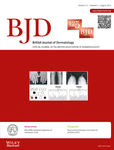

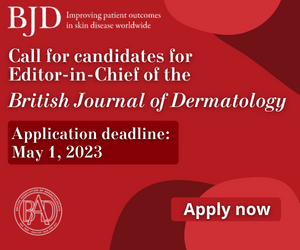
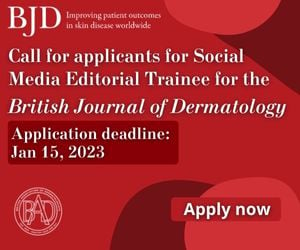

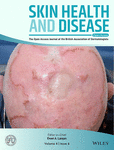
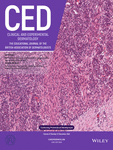
2690-442X.cover.png)